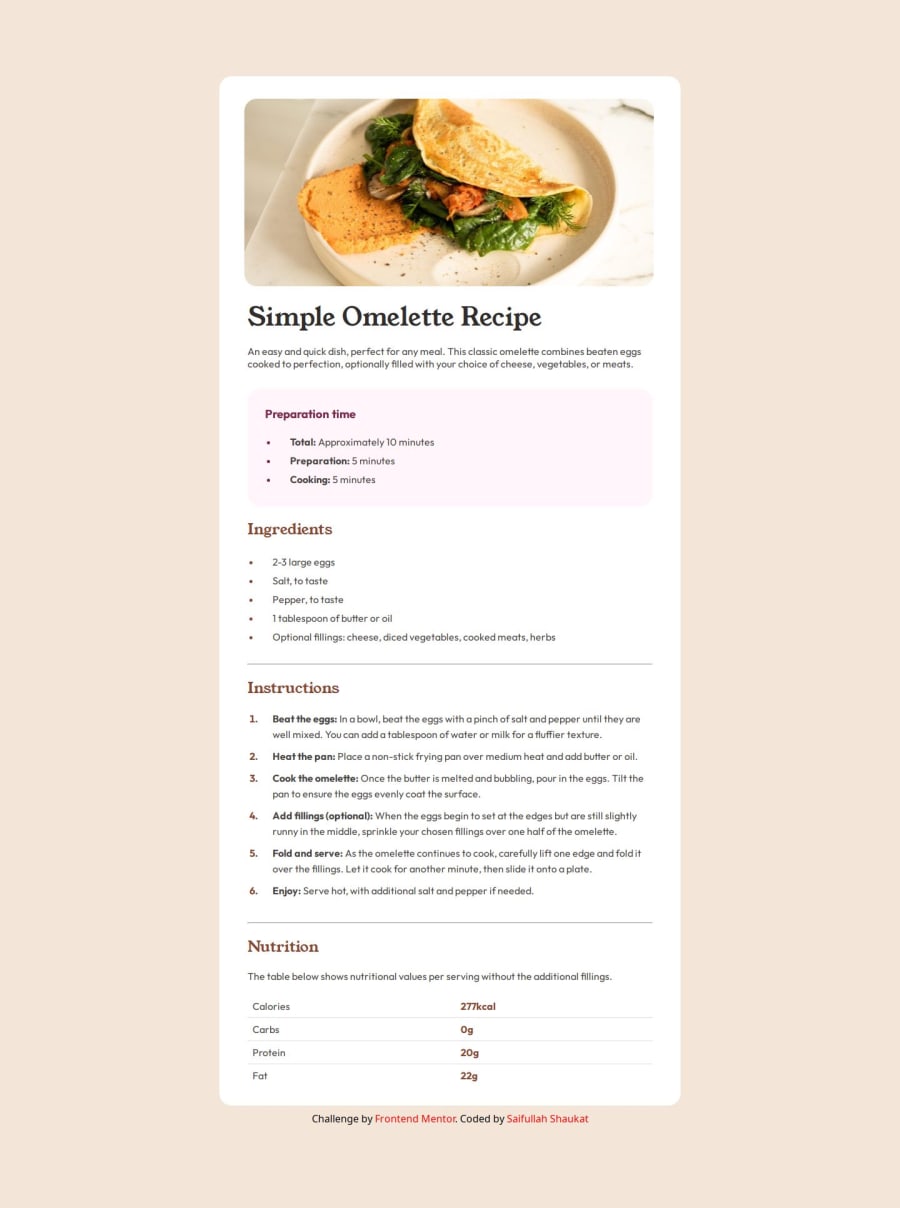
Recipe Page Challenge by Fronend Mentor
Design comparison
Solution retrospective
I started by structuring the HTML document, including necessary tags such as , , and ``. Then, I identified the main components of the page, such as the recipe image, title, preparation steps, ingredients, instructions, and nutrition information, and used appropriate HTML tags to represent them.
After that, I populated the HTML structure with the actual content for the recipe page, including the recipe image, title, ingredients, instructions, and nutrition information.
Next, I opened a CSS file or `` section of the HTML document using Google Fonts or other font providers.
Then, I made the page responsive using media queries to adapt the layout for different screen sizes. I tested the responsiveness of the page by resizing the browser window or using browser developer tools to simulate various devices.
I reviewed the page layout and styling to ensure everything looked as expected and tested the page across different browsers and devices to ensure compatibility and responsiveness. I made any necessary adjustments or fixes based on testing results.
Once satisfied with the layout and styling, I added any final touches such as hover effects, animations, or additional content as needed.
I validated the HTML and CSS code to ensure it met the standards and was free of errors. I optimized the code for performance by minimizing file sizes, reducing unnecessary code, and optimizing images. I also considered accessibility features such as alt text for images and proper semantic HTML tags to improve accessibility for users with disabilities.
Finally, I deployed the page to a web server or hosting platform to make it accessible on the internet.
Built with- Semantic HTML5 markup
- CSS custom properties
In this project, I learned several key aspects of creating and styling a recipe page:
-
HTML Structure: I gained an understanding of how to structure an HTML document, including the proper use of tags such as
,, and ``. I also learned how to identify and organize different components of a webpage using appropriate HTML tags. -
Content Population: I learned how to populate the HTML structure with actual content, including images, text, lists, and other elements necessary for a recipe page.
-
CSS Styling: Through this project, I learned how to apply CSS styles to HTML elements to achieve the desired layout and appearance. This included setting up general styles for the body, targeting specific elements using classes and IDs, and applying styles for typography, colors, spacing, borders, and other visual elements.
-
Responsiveness: I gained experience in making web pages responsive using media queries to adapt the layout for different screen sizes and devices. This involved testing the responsiveness of the page and making adjustments as needed to ensure compatibility across various devices.
-
Final Touches and Optimization: I learned how to add final touches such as hover effects, animations, and additional content to enhance the user experience. Additionally, I gained knowledge of HTML and CSS validation techniques and optimization strategies to improve code quality and performance.
One difficult part of the code may be the implementation of media queries for responsiveness. Here's a snippet demonstrating how media queries can be used to adjust the layout for different screen sizes:
/* CSS for desktop screens */ @media only screen and (min-width: 768px) { /* Add desktop-specific styles here */ } /* CSS for tablet screens */ @media only screen and (max-width: 767px) { /* Add tablet-specific styles here */ } /* CSS for mobile screens */ @media only screen and (max-width: 480px) { /* Add mobile-specific styles here */ }
Understanding how to use media queries effectively and testing them across various devices can be challenging but is crucial for ensuring a seamless user experience across different screen sizes.
What specific areas of your project would you like help with?- Flexbox
- CSS Grid
- Mobile-first workflow
Community feedback
Please log in to post a comment
Log in with GitHubJoin our Discord community
Join thousands of Frontend Mentor community members taking the challenges, sharing resources, helping each other, and chatting about all things front-end!
Join our Discord
